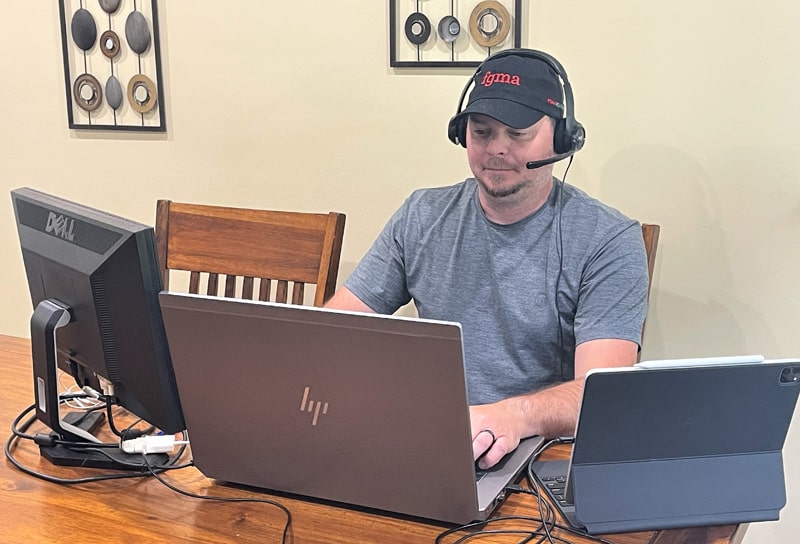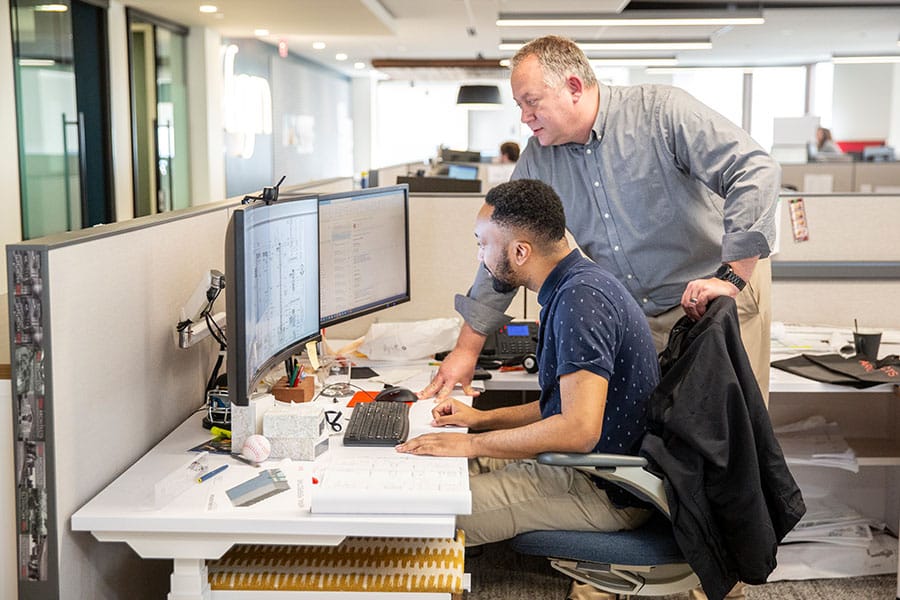For Dwane Lindsey, 2020 was a whirlwind year.
Of course, the year will inarguably go down in the history books as one of the most notable on record, as it was when COVID-19 reached pandemic status, disrupting the world economy and laying the groundwork for post-pandemic life as we now know it.
Still, Lindsey’s 2020 will most certainly be a year he’ll never forget.
That February, Lindsey started a new job as an architectural applications director for FGM Architects (FGMA), a 140-person architecture firm headquartered in the Chicago area, with additional offices in Austin, Texas; Reston, Virginia; St. Louis; and Milwaukee.
His job description upon taking the role was seemingly straightforward: oversee the firm’s architectural applications, building information modeling (BIM) standards, processes and field technologies—all while researching and developing potential new tools that would make the team of architects at FGMA most efficient.
The team at the time was using a simple PDF editing software to mark up and internally collaborate on project documents. From the comfort of their offices, architects would mark up PDFs and save to internal servers for the next person to come in and mark up. Collaboration was largely in person, as colleagues would visit each other’s desks and work together on PDFs.
Going remote
Even in February 2020, Lindsey was certain there was a better way to facilitate such collaboration.
“One of the issues that users came to me was, how can we better collaborate on our PDFs?” Lindsey said. “Right now, person A, they mark up the PDF, they save it, it’s on our servers. Then person B, they do their markups. Person C does their markups. And then the person who’d be picking up those red lines, they have to wait for everybody to be done. They can then pick up the red lines and that whole process just kept going and going and going.”
Lindsey knew right away the solution he wanted to implement to improve this process.
Over the course of his established career in construction technology, Lindsey had become an avid user and advocate of Bluebeam, using the vast digital collaboration capabilities the software offers in many notable projects, including his recent work on the high-profile renovation of Wrigley Field, the historic ballpark of Major League Baseball’s Chicago Cubs.
Lindsey wasn’t the only one at FGMA hoping to implement Bluebeam, either. He said many of the firm’s architects when he first started would ask him when he planned to implement it. At the time, however, Lindsey said there wasn’t a lot of momentum among the firm’s leaders to make a change.
Then March 2020 happened.
It was around the middle of that month that the world seemed to change overnight. COVID-19’s spread reached a critical mass in the United States that shook most office-based companies spanning nearly every sector to send their employees home to work remotely indefinitely. On a dime, most office-based workers in the US economy, including those at FGMA, went home not knowing when they’d return.

Suddenly, FGMA went from having architects working in six offices to 140—one for every employee. Simple PDF editing and collaboration over the firm’s servers at the office was no longer ideal. Any collaboration issues existing with the firm’s previous office-based approach were now compounded.
“How can we now all work remotely and still work together?” Lindsey said he asked himself at the time. “That’s when I brought to our management team the idea of utilizing Bluebeam.”
FGMA’s management team remained skeptical. “The initial feedback was: What will Bluebeam do that we don’t already have?” Lindsey said. “Because based on previous people looking at Bluebeam,” Lindsey said the management team argued at the time, “the program that we have can do 90% of what Bluebeam can do.”
Lindsey’s response was simple: “The 10% that you’re missing by not having Bluebeam is causing 90% of the issues that people have with not being able to collaborate with their PDFs.” This was especially true, Lindsey said, now that the firm was operating remotely due to the pandemic.
The FGMA management team was sold. Lindsey would initiate a company-wide rollout of Bluebeam starting in June 2020.
Focusing the training
Sitting at his makeshift kitchen-table “office,” Lindsey prepared to spearhead a company-wide Bluebeam implementation. It would require months of focused training to get all of FGMA’s architects operational on Bluebeam—training that would take place over videoconference and other digital communication tools.
“I initially kicked off a Bluebeam overview session,” Lindsey said. “It was about a 30-minute session that just gave everybody in the firm a quick overview of what Bluebeam is, what it can do and how we were going to utilize it moving forward.”
Lindsey administered that initial Bluebeam presentation five or six times, he said, to ensure that everyone in the firm had ample opportunity to participate. Each session was also recorded so anyone who couldn’t attend had access to the presentation.
Lindsey was specifically focused on getting the firm’s architects operational on Bluebeam Studio Sessions, the software’s real-time digital collaboration capability.
The firm needed to transition its in-person collaboration needs to an entirely digital environment, and Sessions is designed to do just that.
With Sessions, remote workers can continuously work on uploaded PDF documents in a shared, real-time environment, seeing each other’s markups and discussing issues to resolve. Instead of huddling around a desk in the firm’s office, Sessions allowed the newly remote team members to collaborate digitally from their home offices.
After the initial overview, Lindsey was deliberate in designing the remainder of the implementation training curriculum. To make the learning curve as simple as possible for the firm’s end-users, Lindsey broke down the training program into six sessions, each of which would be administered four times so everyone in the firm could participate:
- Interface
- Markups
- Sessions
- Stamps and Tool Chest
- Searching and Hyperlinking
- Compare and Overlay
With Lindsey as the guide, each training session took place over videoconference, with people following along live in Bluebeam. This allowed attendees to work in the software during training, but then also begin to use Bluebeam in their project work. The Studio Sessions portion of the training occurred in a live Studio Session broadcast over videoconference, so attendees could see in real time exactly what it was like to work in a collaborative environment with the software. These sessions ran from June to August 2020.
Although most of FGMA’s architects took kindly to the training—many even had prior Bluebeam experience—Lindsey said it was still challenging to get people to let go of the previous PDF software.
“That [the old PDF software] was what people were familiar with,” Lindsey said. “And when things were busy during that time, that crutch was still there. So we had to remove the crutch essentially after we got done with the training sessions so that people were, in some respects, forced to go into Bluebeam.”
“That was probably the biggest hurdle,” Lindsey continued. “I think once people got into Bluebeam, they found it pretty easy to use.”
Making a difference
Lindsey said it took about two months—until September/October 2020—after the training period ended before the company was really operating efficiently on Bluebeam.
Throughout the remainder of the year, Lindsey would serve as the firm’s go-to Bluebeam expert, leading all efforts to work out any bugs or issues people were having with the software. In addition to fielding help requests in an ad hoc, informal manner, Lindsey said he would also record and post videos on the firm’s intranet, highlighting workflow features as the firm continued to get acquainted with the software.
FGMA’s implementation and use of Bluebeam was so successful among its architects that, in 2021, Lindsey trained the firm’s marketing department on ways it could be more efficient by using the program.
To date, Bluebeam has streamlined FGMA’s efficiency when it comes to digital collaboration. Lindsey said it played a big role in the firm being able to maintain its operations during the depths of the pandemic. “The fact that people could actively mark up a PDF within a Studio Session at any given time was huge,” he said, because it bolstered communication between architects as communication methods shifted due to remote work.
ALSO ON BUILT:
“If you’re seeing someone mark something up in a Studio Session, you can now either call them or chat them or use whatever communication preference you have,” Lindsey said. “You can start asking questions of their markups without having to literally wait for that person to be done with the document. It’s just a lot more collaborative that way.”
Michael Denz, a design principal at FGMA who is among the firm’s leaders and is a primary end-user after Bluebeam’s implementation, said using Bluebeam has been especially helpful with the firm’s QA/QC process.
“Being able to review progress, printing sets and create markups digitally at various project milestone/phases allows for everyone on the project team to stay up to speed on changes in project scope and the development of details,” he said. “As someone who is responsible for overseeing the design process and the development of the design, Bluebeam has given me the peace of mind I need to ensure we deliver a successful project for all of our clients.”
Broadening use
Today, most of FGMA’s architects are back working in one of the firm’s offices, but Lindsey said use of Bluebeam has continued to enhance collaboration, especially as some people still occasionally work remotely and more cross-office projects are taking place. The time savings from using Sessions has been noticeable as well, Lindsey said, although the firm hasn’t been able to precisely quantify how much time implementing Bluebeam has saved.
The biggest lesson Lindsey said he took away from having to lead a Bluebeam implementation in the middle of a once-in-a-lifetime pandemic with employees scattered remotely is to simplify the training.
Lindsey was intentional at the outset by only delivering training on six high-level topics and features that the firm’s architects would find most useful in the near-term, careful not to overwhelm people with everything Bluebeam has to offer. He would recommend the same for anyone else looking to engage in a similar company-wide implementation.
“Nobody’s going to retain all that information in a short amount of time,” Lindsey said.
That said, now that the initial training and adoption is complete, FGMA is looking to expand how it uses Bluebeam to fully realize the complete scope of the software’s capabilities.
“It [Bluebeam] started to open people’s eyes,” Lindsey said. “We started looking at facility condition assessments, going into a building and the need to document what’s in there. How can we do that? We don’t want to use paper and pencil anymore. Can we utilize Bluebeam for that? We’re starting to look at more and more ways to get utilization out of the software, because it has a lot of capabilities to it.”












